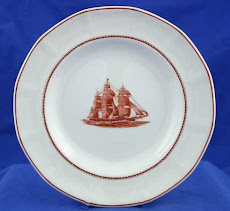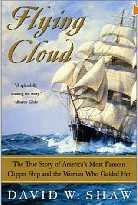
Although the easily recognizable image of the famous Flying Cloud clipper ship appears on most of the pieces in the pattern, the images of a few other famous clipper ships also appear on some of the pieces. In addition to their images, the names of those ships appear on the bottom of the pieces. Those pieces are as follows:
Top left - The Game Cock, launched on December 21, 1850. (A figurehead of a gamecock with an outstretched neck graced the bow of the heavily-sparred Game Cock clipper.) The Game Cock was owned by a man named Daniel C. Bacon. (Click here for a web site with more information.) By the way, the game Cock was launched the same day in the same shipyard in Boston as another clipper, the Witchcraft, which was slightly smaller than the Game Cock. My guess is that Wedgwood decided wisely decided against putting that name on any of its china.
Top right - The Ann McKim, launched in 1833. This ship, considered to the first clipper ship, was owned by Isaac McKim, who named it after his wife. Building it was considered a radical experiment at the time, but it then went on to become the model for many of the clipper ships built over the next 25 years. (Click here for more information.)
Bottom right - The Red Jacket clipper ship was built in Maine, from where, on November 2, 1853, she was towed to New York for final fitting of her mast and rigging. This extreme clipper ship, which set the unbroken speed record from New York to Liverpool, was named after Red Jacket (1750-1830) --- known as Otetiani in his youth and Segoyewatha ("he keeps them awake") after 1780 --- was a Native American Seneca chief of the Wolf clan and orator who traditionally wore a red jacket given to him by the British. As a tribute to her namesake, The Red Jacket carried a life-sized carving of him as a figurehead. She was also considered the handsomest of the large American built clippers until her end when, in a storm on December 15, 1885 she parted her moorings and was wrecked ashore. (Click here for more information.)
Bottom left - Tine Young America, launched April 30, 1853, in New York for George B. Daniels. On February 17, 1886, she passed the Delaware Breakwater outward bound from Philadelphia for Fiume and was never heard of again. (Click here for more information.)
The origins and evolution* of Wedgwood's fascination with the American clipper ship are perhaps known only to it, but the clipper ships appeared on the scene 38 years after Josiah Wedgwood's death in 1795. Perhaps it may be because those speedy clipper ships help speed the delivery of orders of Wedgwood's famous pieces around the world and the pattern was a tribute to their role in the growth of the company, especially in a growing America.
* Sspeaking of evolution, Charles Darwin was grandson of Josiah Wedgwood (and, I believe, Darwin married a Wedgwood relation). Darwin's famous ship, The Beagle, launched on May 11, 1820, was not an American clipper ship, given that it was launched on May 11, 1820, 13 years before the first American clipper, and was built at the Woolwich Dockyard on the River Thames in England.




No comments:
Post a Comment